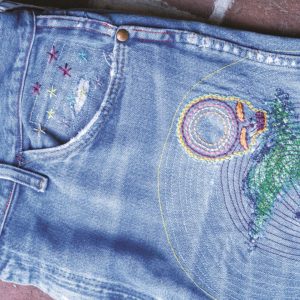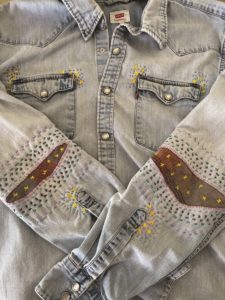PROVINCETOWN — There is one thing Evelina Kirgan cannot forget from her years as an assistant designer at Ralph Lauren. It’s the time she ordered 50,000 yards of the wrong polka-dot fabric.
“I almost had a heart attack,” she says, remembering the experience that made her reconsider her role in the fashion industry.

“I don’t want to do this anymore,” she recalls thinking. The incident drove home a point that bothered her about the industry: “Nothing about it was sustainable,” she says.
Now Kirgan lives in Provincetown and Burlington, Vt. Slowly, she has found her way to working with clothes differently. Her artistic repairs of worn clothing are both sustainable and creative practices.
Kirgan grew up reading fashion magazines, even though her family lived on a farm in rural Illinois. “I’ve always been into clothing and style,” she says.
Her interest in fashion led her to Columbia College in Chicago, where she earned a degree in fine arts and fashion design. From there she moved to New York City, where she interned for Marc Jacobs before working at Ralph Lauren for seven years.
After Kirgan left her job at Ralph Lauren, she stayed in the city, studying music briefly before picking up a part-time retail job at Patagonia.
“I loved their environmental ethos,” Kirgan says. “They want someone to buy a $400 jacket and then take care of it.” Kirgan admired Patagonia’s policy of providing free repairs of its products.
With her informed eye, Kirgan began noticing a lack of quality in the third-party repairs being sent back to the store. Her co-worker, Alexis O’Kulich, also went to fashion school, and the friends had a “meeting of the minds,” Kirgan says. The two persuaded their supervisor to let them set up a sewing machine and do repairs in the store rather than sending them out to vendors.

The idea took off. When Patagonia moved its flagship store to Greene Street in SoHo in 2015, the company set up a full in-store repair station, which currently repairs nearly all returned items from the Northeast.
“There was something about this I needed,” Kirgan says. The work was “more crafty, more creative,” and involved “more problem solving.”
Kirgan began developing a side hustle doing creative repairs, often for people from the Grateful Dead community. A longtime fan of the music, Kirgan would often take time off to follow bands that played their songs, including Phil and Friends and Dark Star Orchestra. She made small items — pot holders with stitched Grateful Dead imagery or dyed socks — to sell along the way at “shakedowns,” which Kirgan describes as “parking lot scenes” where people sold everything from tie-dyed shirts to prepared food.
Kirgan began embroidering images such as Grateful Dead lightning bolts on fans’ clothing. She enjoyed helping people avoid buying new clothes by making what they already had more special.
When people started bringing her items to repair and embellish with creative stitching and patches, Kirgan came to accept her vocation. “I’m a person who works with my hands,” she realized. “I’m going to use repair as my medium.”

At the end of 2019, she left New York for Vermont, where she supported herself taking in repair work. She found her customers — or more precisely they found her — via Instagram. She named her fledgling company Satellite Repairs because her dream had been to do her repair work remotely.
Kirgan recently finished working on a pair of jeans that belong to a man who contacted her seeking to salvage the shredded pair he always wore to shows. A lot of Kirgan’s work requires reconstructing items, and for this piece she started from the inside of the jeans, covering damaged areas with circular patches of duck canvas, colored with natural dyes.
“Things appear from the damage,” says Kirgan. The holes she darned became constellations in green thread. She embroidered Grateful Dead imagery into the garment — lightning bolts and a wagon wheel with roses.
“Everyone has worn-out things they love,” says Kirgan, although not everyone is “crazy enough” to put in the painstaking effort to fix them. She spends many hours, sometimes days, working on her projects. For this repair she charged $650.
“I know it’s a lot,” she says. “I have to charge what makes me feel like I’m not doing it for nothing.”

Repairs come with constraints, says Kirgan, who balances her repair work with creative projects done for her “own indulgence.” She dyes blankets with natural materials such as logwood, which results in a rich purple, and weld, which creates a chartreuse hue. She has just finished a coiled rug, crocheting strips of dyed fabric with hemp cord.
“I torture myself,” Kirgan says. “Everything takes so long and requires so much hand strength.” As a child, she hated sewing and didn’t learn it until fashion school. She’s not one of those people who learned to sew from her grandmother, she says, and grew up being good at it. Although her grandmother did excel at making clothes, she says, her mother didn’t continue the tradition of making and repairing clothing.
Kirgan’s growing up coincided with a moment in American history when clothing became cheap, consumption was encouraged, and gendered roles in the home reconsidered. But now “there is a resurgence of people wanting to fix their things,” she says, and a resistance to disposable goods.
Her work has, in a way, brought her back to her roots as the offspring of a long line of farmers. In her family, “nobody was really artistic, but everyone worked with their hands,” she says. “That’s ingrained in me.”



